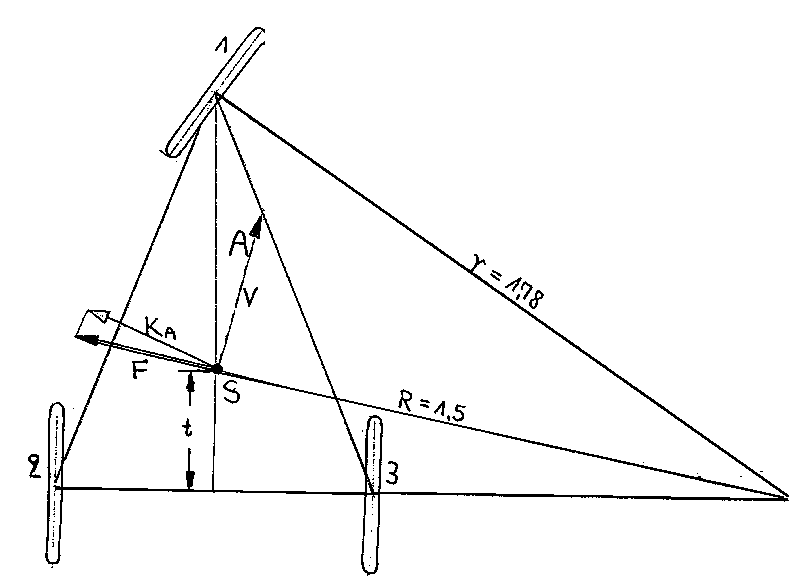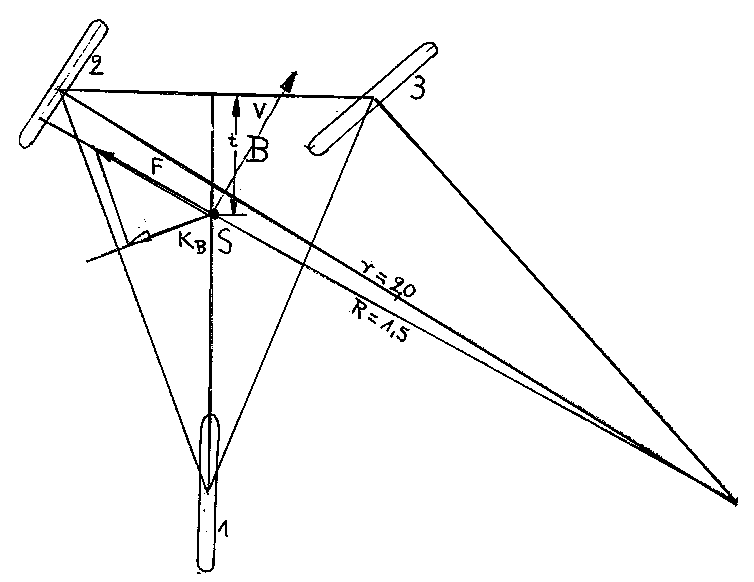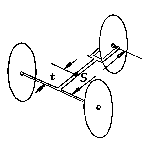Tilt resistance of tricycles
Author: W. Stiffel Im Holderbusch 7 D-76228 Karlsruhe Germany
In the following chapter, two vehicles A and B with the same properties are compared (weight, gauge and height of the center of gravity). If they are travelling around a
curve with the speed v, the center of gravity is on the same Radius R. At higher speeds, both vehicles will tilt over. Geometrically, they will tilt over a connecting line of the normal projection of the wheels 1 and 2 onto the
road.
The same centrifugal force acts on both vehicles at the center of gravity.
At A, the centrifugal force acts via the normal component K, and a similar influcence for B. Because the distance between the
center of gravity and the tiling line is the same in both cases and K is approx. 50% larger than K, the wheel B tilts at a speed that is 23% higher (there is a square term in the centrifugal force). At higher speeds and thus
higher radii, the difference is smaller. At high braking, the difference is higher. On the other side, at A, the distance t can be smaller, because traction is no problem and there is no problem with righting up when braking.
 |
 |
Regarding tricycles, the resistance versus tilting is better if the center of gravity is close to the axis with the two wheels. Using a construction with two wheels in the front ("T-type" or "tadpole"), the constructor has to do a trade-off. On the one hand, it is a good deal to keep the center of gravity at 15% of the wheel base behind the front axle. In this case, tilting is no problem (at high tracks and a low seating position). On the other hand, the vehicle is righting up when braking. In addition, the vehicle comes out of track when riding downhill and the rear tire looses traction.
 |
Regarding the "Trice" with 25% load on the rear wheel, starting at hills with more than 10% ascending slope on bad ways is impossible. For everyday situations, I think a load of 35% of the rear wheel compared to the total weight is a good compromise. At my 3R/7 (2 wheels in the rear, "delta" construction), I fixed the seat far in the rear part of the vehicle (82% load on the rear wheel axle). This gives a very good resistance against tilting and a good traction of the driven wheel. If there is still a problem with the traction of the vehicle, I will move to the left side of the seat and tilt the body to the left hand side. Disadvantage: when starting at hills, the front wheel can move to the right hand side because the left wheel is driven. The seating height is as low as possible (300mm at my 3R7), because this tricycles is mostly not a vehicle for urban traffic und thus resistance against tilting is more important than overview.
Influence of the wheel base on tilting.
Tricycles with two wheels in the front:
Dave Angler built tree different tricycles, that differ by the wheel base. They had a track of 625-680 mm and a ground clearance of 100-125 mm.
At a wheel base of 1700 mm he felt secure up to a speed of 108 km/h (68 mph) riding downhill. Using a wheel base of 1300 mm, he stopped feeling secure at 90 km/h (56 km/h) and at a wheel base of 1000 mm, he braked at a speed at 55 km/h (34 km/h). The turning circle was reduced from 11,5 down to 3-4 m. A wheel base of 1000 mm and a sufficient load on the rear wheel can be only achieved by a small rear wheel (500 mm, 406 type). Dave came to the following results (and I agree with them):
- a short wheel base (800 - 1000 mm) gives a compact, manoeuvrable and rigid vehicle. Such a vehicle is ideal for mean speeds maximally. The traction is very good an tilting is normally no problem.
- a long wheel base gives a comfortable vehicle with a good directional stability up to highest speeds. When braking, the rear wheel tends to swing sidewards.